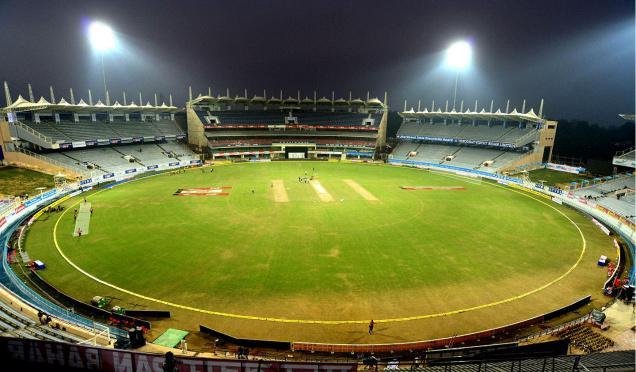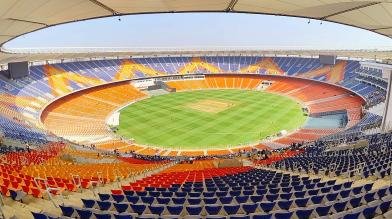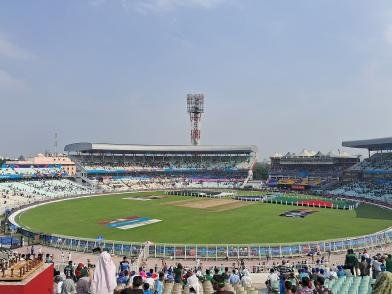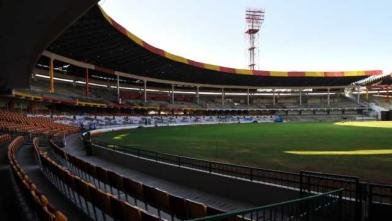٨ـ❤️ﮩ٨ـ Pulse of Mohali
Welcome to the I.S. Bindra Punjab Cricket Association Stadium, fondly known as the Mohali Stadium, a cricketing jewel nestled in Punjab, India. Renowned for its rich history, innovative design, and electrifying atmosphere, this venue has carved a special place in the hearts of cricket fans worldwide. Below is an in-depth exploration of its story, architecture, iconic moments, and what makes it truly unique.
History of the Stadium
The Mohali Stadium is a testament to vision, engineering prowess, and Punjab’s love for cricket.
- When and How Built:
Construction began in 1992 on a swampy, challenging terrain that required innovative stabilization techniques. Designed by Ar. Arun Loomba and Associates and executed by R.S. Construction Company, the stadium was completed in just three years at a cost of ₹250 million. It was inaugurated on 22 November 1993 with a thrilling One Day International (ODI) between India and South Africa, marking Punjab’s entry into the international cricketing arena. The rapid transformation of the site into a world-class venue remains a remarkable achievement. - Purpose:
The Punjab Cricket Association (PCA) envisioned the stadium as a state-of-the-art facility to bring international cricket to Punjab, a region previously without such a venue. Beyond hosting global matches, it aimed to nurture local talent, promote grassroots cricket, and serve as a hub for domestic tournaments. Over the decades, it has lived up to this vision, becoming a cornerstone of Punjab’s cricketing identity. - Significant Events:
In 2015, the stadium was renamed in honor of Inderjit Singh Bindra, a legendary cricket administrator instrumental in elevating Indian cricket’s global stature. It has hosted landmark events, including:- The 1996 World Cup Semi-Final between Australia and West Indies, a dramatic encounter etched in cricket lore.
- The 2011 World Cup Semi-Final between India and Pakistan, a match that doubled as a diplomatic spectacle attended by leaders of both nations.
- Regular Indian Premier League (IPL) matches as the home ground of the Punjab Kings, delivering countless T20 thrillers.
Location and Accessibility
Strategically located, the Mohali Stadium balances accessibility with a serene setting.
- Where:
The stadium is situated in Sector-63, S.A.S Nagar, Mohali - 160062, Punjab, India, just outside the bustling city of Chandigarh. This positioning offers a peaceful escape while remaining close to urban amenities. - How to Reach:
- Air: The Chandigarh International Airport, approximately 15 kilometers away, is the nearest air hub. A 20-30 minute taxi or cab ride brings you to the stadium gates.
- Road: Mohali enjoys excellent road connectivity, with frequent bus services from Chandigarh, Ludhiana, and Amritsar. Taxis and ride-sharing apps like Uber are widely available.
- Rail: The Chandigarh Railway Station, about 12 kilometers from the venue, is the closest rail link. From there, a short auto-rickshaw or taxi ride completes the journey.
- Nearby Landmarks:
Chandigarh’s iconic attractions—such as the artistic Rock Garden, tranquil Sukhna Lake, and the architectural marvel of the Capitol Complex (a UNESCO World Heritage Site)—are within easy reach, making a match day a perfect excuse for a broader exploration. - Recent Developments:
While IPL matches have shifted to the new Maharaja Yadavindra Singh International Cricket Stadium in Mullanpur since 2024, the Mohali Stadium continues to thrive as a venue for international and domestic cricket, with plans for further upgrades.
Architecture and Design
The Mohali Stadium blends practicality with innovation, creating an exceptional experience for players and spectators alike.
- Seating Capacity:
With a capacity of 26,950, the stadium offers an intimate yet vibrant atmosphere. Seating is divided into:- North Pavilion: Premium seating with superior views.
- South Pavilion: A mix of general and VIP options.
- East and West Stands: Affordable sections ensuring inclusivity for all fans.
- Unique Features:
- Floodlights: The stadium features 16 low-height floodlights, a rare design necessitated by its proximity to Chandigarh Airport. This setup avoids aviation conflicts while providing excellent illumination for night matches, enhancing both safety and spectacle.
- Pitch: Once known for its lightning-fast, bowler-friendly nature, the pitch has evolved into a batsman’s delight with a hard, bouncy surface. It often retains a slight green tinge early on, assisting fast bowlers, but flattens out to favor high scores. In Test matches, spinners find assistance as the surface wears.
- Field and Pitch Characteristics:
- Outfield: The lush, well-maintained grass ensures one of India’s fastest outfields, enabling quick ball movement and spectacular fielding.
- Pitch Stats: In ODIs, the average first-innings score is around 270, while T20Is average 170. In Tests, it has produced massive totals, like New Zealand’s 630/6d in 2003, reflecting its batting-friendly evolution.
Famous Matches and Events
The Mohali Stadium has been a crucible for cricketing greatness.
- Memorable Matches:
- 1996 World Cup Semi-Final (Australia vs. West Indies): A collapse of 8 wickets for 37 runs handed Australia a famous victory, showcasing the stadium’s early flair for drama.
- 2011 World Cup Semi-Final (India vs. Pakistan): Watched by millions, this match transcended sport, with India’s win propelling them to World Cup glory. The presence of both nations’ Prime Ministers added a historic dimension.
- 2007 Test (India vs. Pakistan): A gripping draw where India fell one wicket short of victory, and Pakistan clung on with their last pair.
- IPL Highlights: As the Punjab Kings’ home, it has hosted classics like the 2014 Eliminator, where a 226-run chase stunned Chennai Super Kings.
- Records:
- Highest Test Total: 630/6d by New Zealand vs. India (2003).
- Highest Individual Score: 187 by Shikhar Dhawan in his debut Test vs. Australia (2013).
- Best Bowling: 8/86 by Javagal Srinath vs. Pakistan (1999).
- Fastest Century: Virender Sehwag’s 69-ball ton vs. New Zealand in an ODI (2009).
- Other Events:
The stadium is a regular host for domestic tournaments like the Ranji Trophy and Vijay Hazare Trophy, fostering Punjab’s cricketing talent.
Facilities
The Mohali Stadium ensures a top-tier experience for all stakeholders.
- Spectators:
- Seating: Comfortable with excellent sightlines across all sections. The North Pavilion offers padded seats, while the East and West Stands cater to budget-conscious fans.
- Food: Stalls serve a mix of Punjabi favorites like chole bhature and universal options like burgers and soft drinks.
- Parking: Ample spaces, including designated areas for VIPs and differently-abled visitors.
- Players:
- Dressing Rooms: Spacious and modern, with recovery facilities and massage areas.
- Practice Nets: Multiple high-quality nets allow teams to hone their skills pre-match.
- Media:
- Broadcasting: A cutting-edge media center with high-speed internet and advanced camera setups supports seamless live coverage.
- Press Box: Well-equipped for journalists to report the action in real-time.
Unique Features
The stadium’s distinctive elements elevate it above the ordinary.
- Floodlights:
The 16 low-height floodlights are both functional and visually striking, ensuring flawless night games without towering structures. - Drainage System:
A herringbone drainage system—one of India’s best—clears rainwater in 25-30 minutes, minimizing disruptions and showcasing engineering excellence. - Stands Named After Legends:
In 2022, stands were named after Punjab’s cricketing icons Harbhajan Singh and Yuvraj Singh, honoring their contributions and inspiring future stars. - Sustainability:
Solar panels on the roof reflect a commitment to eco-friendly operations, setting a benchmark for other venues.
Fan Experience
A match at Mohali is a sensory delight.
- Atmosphere:
The roaring crowd—especially during IPL clashes and India-Pakistan showdowns—creates an electric vibe. The compact seating ensures fans feel immersed in the action, with flags waving and chants echoing. - Reviews:
Fans rave about the clear views, lively ambiance, and easy access to Chandigarh’s attractions. One visitor described it as “a festival of cricket—energy everywhere you look.” - Extras:
During IPL seasons, fan zones offer games, merchandise, and giant screens, complemented by live music and cheerleaders.






